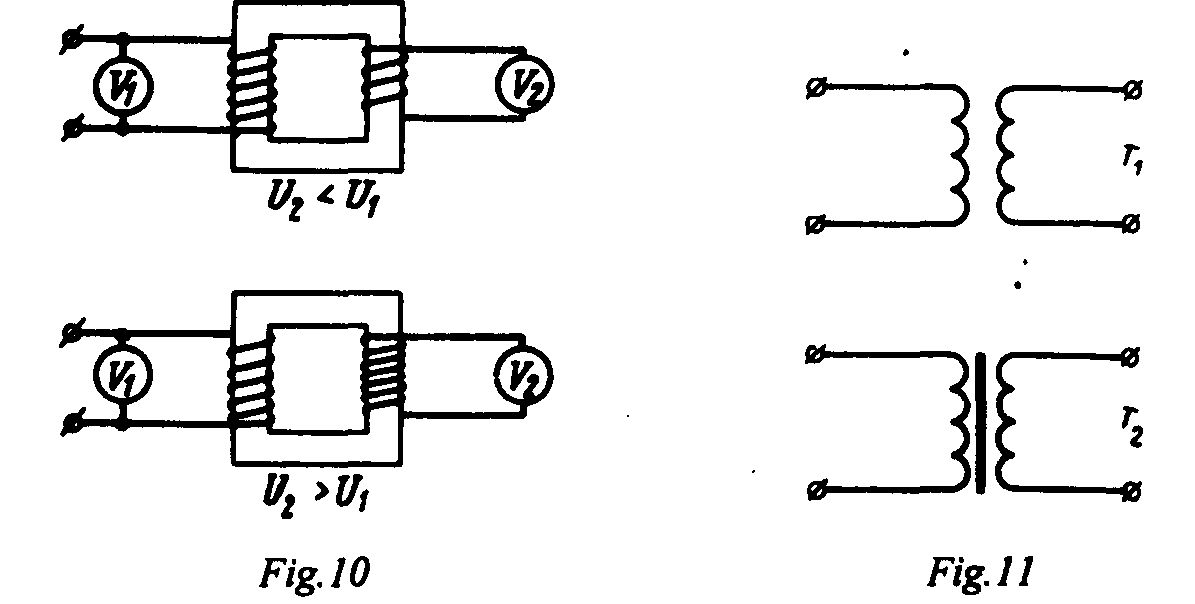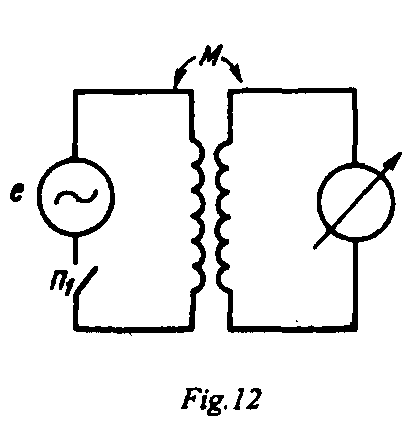
- •1. Electric Circuit. (Unit 5)
- •2. Series Circuit and Parallel Circuit. (Unit 6)
- •3. Meters. (Unit 7)
- •4. Resistor. (Unit 8)
- •5. Electric Cells. (Unit 9)
- •6. Capacitors. (Unit 10)
- •7. Conductors and Insulators. (Unit 11)
- •8. Transformers. (Unit 12)
- •9. Types of Current. (Unit 13)
- •10. Inductance and Mutual Inductance. (Unit 14)
- •11. Coupling . (Unit 15)
8. Transformers. (Unit 12)
A transformer is used to transfer energy. Due to the transformer electric power may be transferred at a high voltage and reduced at the point where it must be used to any value. Besides, a transformer is used to change the voltage and current value in a circuit.

A two-winding transformer consists of a closed core and two coils (windings). The primary winding is connected to the voltage source. It receives energy. The secondary winding is connected to the load resistance and supplies energy to the load.
The value of voltage across the secondary terminal depends on the number of turns in it. In case it is equal to the number of turns in the primary winding the voltage in the secondary winding is the same as in the primary.
In case the secondary has more tums than the primary the output voltage is greater than the input voltage. The voltage in the secondary is greater than the voltage in the primary by as many times as the number of turns in the secondary is greater than the number of turns in the primary. A transformer of this type increases or steps up the voltage and is called a step-up transformer. In case the secondary has fewer tums than the primary the output voltage is lower than the input. Such a transformer decreases or steps down the voltage, it is called a step-down transformer.
Compare T1 and T2 in the diagram. T1 has an iron core. For this reason it is used for low-frequency currents. T2 has an air core and is used for high frequencies.
Common troubles in transformers are an open in the winding, a short between the primary and the secondary, and a short between turns. In case a transformer has a trouble it stops operating or operates badly. A transformer with a trouble should be substituted.
9. Types of Current. (Unit 13)
Current is a flow of electricity through a circuit. Let us consider two main types of current direct and alternating. A direct current (d.c.) flows through a conducting circuit in one direction only. It flows provided a direct voltage source is applied to the circuit.
An alternating current (a.c.) is a current that changes its direction of flow through a circuit. It flows provided an alternating voltage source is applied to the circuit. Alternating current flows in cycles. The number of cycles per second is called the frequency of the current. In a 60-cycle alternating current circuit the current flows in one direction 60 times and in the other direction 60 times per second.
It is easy to transform a.c. power from one voltage to another by a transformer. Transformers are also used to step down the voltage at the receiving point of the line to the low values that are necessary for use.
When necessary a.c. can be changed into d.c. but this is seldom necessary.
10. Inductance and Mutual Inductance. (Unit 14)
Any conductor has some definite value of inductance. The inductance of a conductor shows how well it can provide induced voltage.
Elements of a circuit with definite value of inductance are coils of wire called inductors. The inductance of a coil depends upon its size and material. The greater the number of turns of a coil, the higher is its inductance. An iron core also increases the value of inductance. Coils of this type are used for low-frequency currents while coils with an air core are used for high-frequency currents.
Two coils A and Bare brought close together and a
source of varying current is applied to coil A. If a measuring
device is connected across the terminals of col B it will be found
that a voltage is induced in this coil though the two cols do not
touch. The secondary voltage, that is the voltage in coil B, is
called induced voltage and energy from one coil to the other
transfers by induction. The coil across which the current is applied
is called the primary; that in which voltage is induced is called
the secondary. The primary and the secondary coils have mutual
inductance. Mutual inductance is measured in the same units as
inductance, that is in henries.
Thus, when a rate of change of one ampere per second in the primary coil will produce one volt in the secondary coil, the two coils have one henry of mutual inductance.
It should be taken into consideration that induction by a varying current results from the change in current not in the current value. The faster the current changes, the higher the induced voltage.
